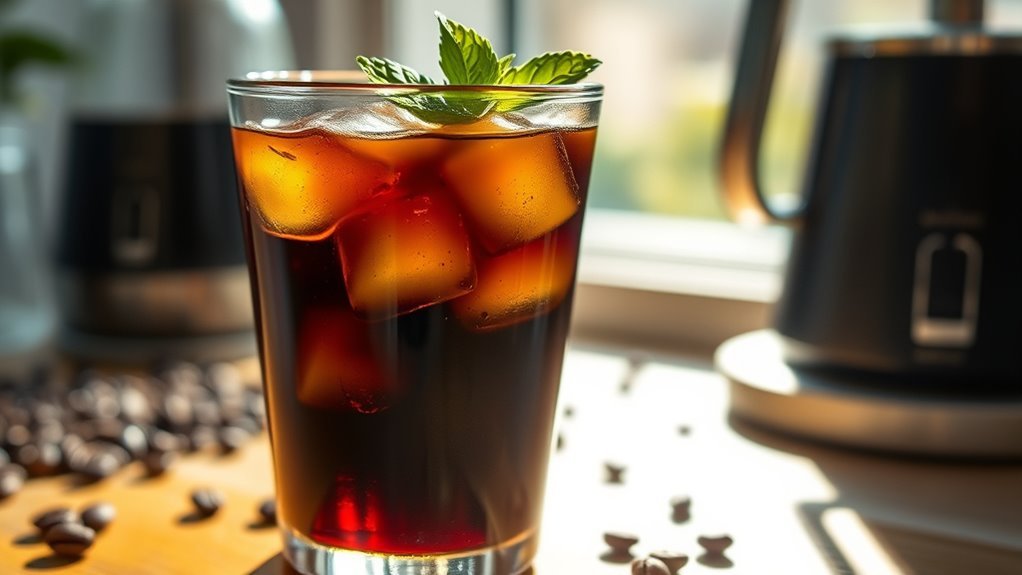The Benefits of Cold Brew Coffee
Cold brew coffee offers you a smoother, less acidic taste by using cold water steeping over 12–24 hours, reducing bitter compounds and stomach irritation. You’ll benefit from stable, longer-lasting caffeine absorption without jitters, thanks to slower metabolism. It’s convenient to make in large batches with minimal energy, minimizing environmental impact through lower waste and eco-friendly packaging. Plus, it supports hydration with less acidity. Discover how these advantages can enhance your coffee experience and well-being.
What Makes Cold Brew Coffee Different
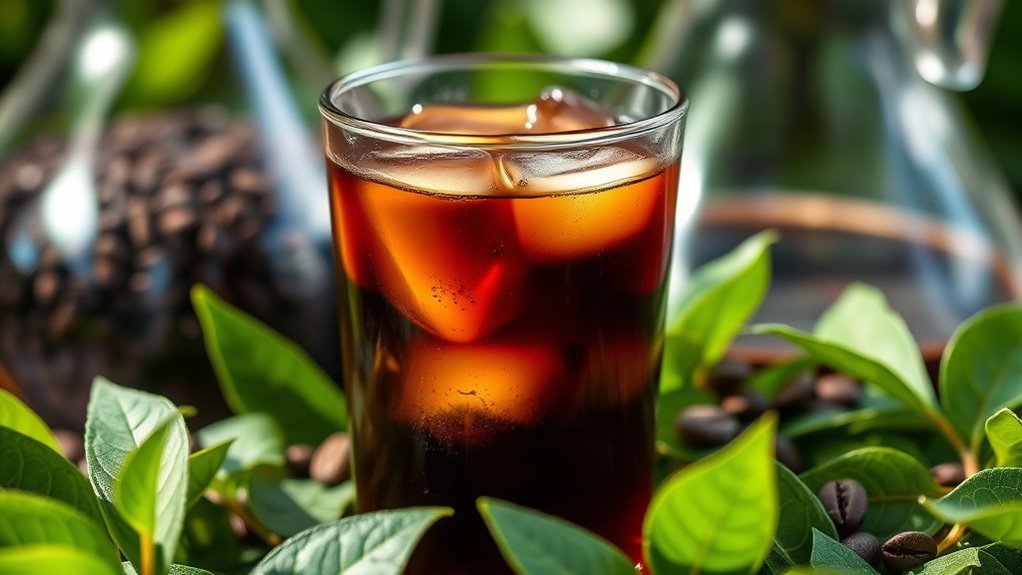
Cold brew coffee differs primarily in its extraction method, which uses cold or room temperature water over an extended period, typically 12 to 24 hours. Unlike traditional hot brewing methods that rely on high temperatures to extract compounds rapidly, cold brewing employs a slow, controlled process. This method allows you to selectively extract specific soluble compounds, resulting in distinct flavor profiles. With cold brew, you’re minimizing the extraction of acidic and bitter elements, emphasizing sweeter, smoother notes. Understanding these brewing methods empowers you to tailor your coffee experience, granting freedom from the constraints of conventional hot brewing. By mastering cold brew’s unique extraction, you gain precision in crafting a coffee that highlights nuanced, balanced flavors, offering a versatile alternative that fits your taste preferences and lifestyle.
Smoother Taste With Less Acidity
Because the extraction process occurs at lower temperatures over an extended period, you’ll notice that cold brew coffee contains considerably fewer acidic compounds compared to hot brewed coffee. This difference arises because heat intensifies the solubility of chlorogenic acids and other acidic molecules, which cold brew’s gentle brewing methods minimize. As a result, the flavor profile of cold brew is smoother, with reduced sharpness and bitterness. You’ll experience nuanced sweetness and subtle chocolate or fruity notes that are often masked in traditional hot brews. By controlling variables such as grind size, steeping time, and water temperature, you can further refine the balance between extraction efficiency and acidity. This method grants you greater freedom to enjoy a coffee that’s rich and complex yet easy on your palate.
How Cold Brew Is Gentler on Your Stomach
While traditional hot coffee can sometimes cause stomach discomfort due to its higher acidity and temperature, cold brew offers a gentler alternative by greatly reducing acid content and temperature-related irritation. The cold brew process, which involves steeping coffee grounds in cold water for an extended period, extracts fewer acidic compounds like chlorogenic acid lactones and quinic acid, known contributors to stomach sensitivity. This results in a brew with a considerably lower pH level, promoting enhanced digestive comfort. Additionally, cold brew’s cooler serving temperature prevents thermal irritation of the gastric mucosa, minimizing the risk of acid reflux or gastritis. If you experience stomach sensitivity, switching to cold brew can provide a smoother, less aggressive coffee experience that supports your digestive system without compromising flavor.
Longer Lasting Caffeine Effects
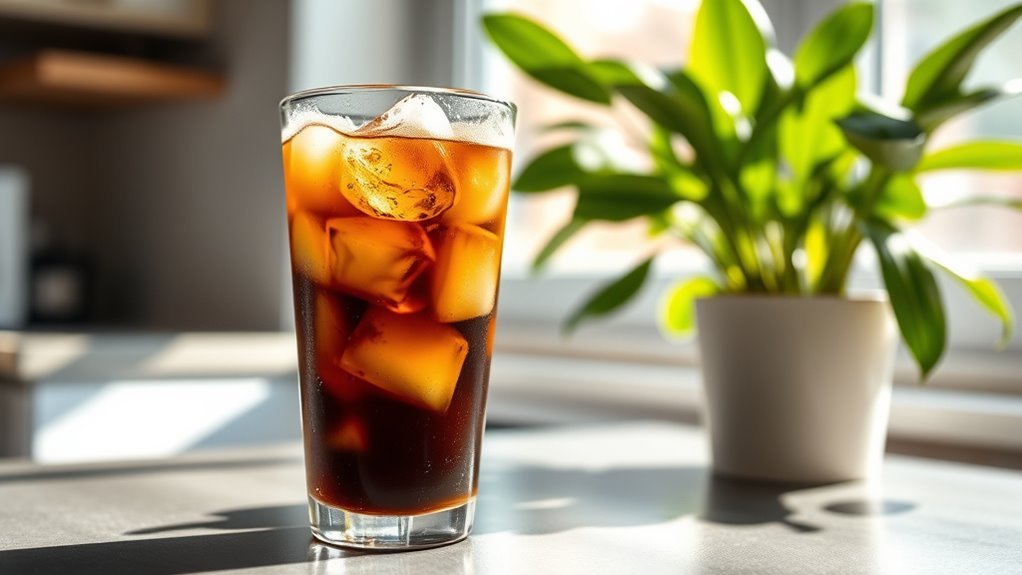
Beyond its gentler impact on your stomach, cold brew coffee also influences how caffeine affects your body over time. The lower acidity and unique extraction process slow caffeine metabolism, meaning caffeine enters your bloodstream more gradually. This extended absorption stabilizes energy levels without the sharp peaks and crashes typical of hot brewed coffee. For you, this translates into sustained cognitive alertness and physical readiness, enhancing both focus and endurance over hours. By modulating enzyme activity that breaks down caffeine, cold brew guarantees a smoother, more controlled stimulant effect. If you value lasting energy without jitters or sudden drops, cold brew offers a biochemical advantage, aligning with your desire for steady, reliable performance throughout the day. This measured caffeine release supports freedom in managing your daily rhythm effectively.
Convenience and Versatility in Preparation
Three key factors make cold brew coffee exceptionally convenient and versatile to prepare: its extended brewing time, minimal equipment requirements, and adaptability to various flavor profiles. You don’t need specialized machines; a simple jar or pitcher suffices, allowing you to choose from multiple brew methods—steeping coarse grounds in cold water for 12 to 24 hours. This slow extraction reduces acidity while revealing nuanced flavor infusions. You can experiment by adding spices, citrus peels, or vanilla during brewing to customize taste without altering the process. Because cold brew concentrate stores well refrigerated, you can prepare large batches ahead, granting you freedom to enjoy smooth coffee whenever you like. This flexibility in preparation and flavor modulation makes cold brew ideal for those who value efficiency without sacrificing complexity.
Cold Brew’s Impact on Hydration
The convenience and customizable nature of cold brew coffee also influence how it fits into your daily hydration routine. Unlike traditional hot coffee, cold brew’s lower acidity and smooth flavor allow you to consume it in larger volumes without discomfort, supporting better fluid intake. Hydration science shows that beverages containing caffeine can contribute to your overall hydration status when consumed in moderate amounts. Cold brew’s dilution potential means you can adjust caffeine concentration to optimize hydration benefits without overstimulation. Additionally, its cold temperature may promote increased fluid consumption, especially in warm climates or post-exercise scenarios. By integrating cold brew thoughtfully, you maintain electrolyte balance and hydration efficiency, aligning with your goal for freedom in beverage choices while respecting the body’s hydration needs precisely.
Potential Antioxidant Benefits
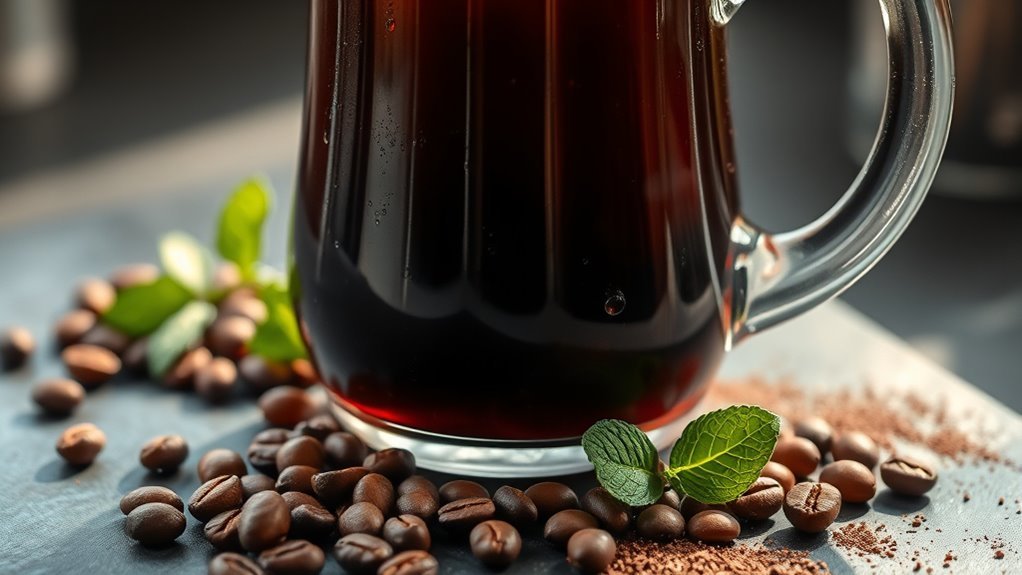
You’ll find that cold brew coffee contains a distinct profile of antioxidants compared to hot brewed varieties, with variations in chlorogenic acid levels. These antioxidants play a critical role in neutralizing free radicals, potentially reducing oxidative stress in your cells. Understanding these differences can help you evaluate cold brew’s contribution to long-term health benefits.
Antioxidant Levels Compared
Although cold brew coffee is often praised for its smooth taste, its antioxidant content plays an essential role in its health benefits. When comparing antioxidant levels, cold brew typically contains slightly lower concentrations of certain polyphenols, such as chlorogenic acids, compared to hot brewed coffee. However, the extended steeping time in cold water alters the extraction profile, potentially enhancing the bioavailability of other antioxidant compounds. As an antioxidant source, cold brew may facilitate improved antioxidant absorption due to its lower acidity, which can influence gastrointestinal uptake. This nuanced balance means while you might encounter fewer total antioxidants per serving than hot brew, the form and matrix in cold brew could optimize your body’s utilization. Understanding these distinctions empowers you to choose the coffee style that aligns best with your freedom to prioritize antioxidant intake and absorption.
Health Impact Insights
Since cold brew coffee’s antioxidant profile differs from hot brew, its health impacts warrant specific consideration. You’ll find that cold brewing extracts distinct polyphenols with altered bioavailability, potentially enhancing certain health benefits. These antioxidants combat oxidative stress, which is linked to chronic diseases, thereby supporting overall cellular health. Furthermore, cold brew’s lower acidity may reduce gastrointestinal discomfort, allowing you to enjoy these benefits without adverse effects. The unique extraction process also preserves compounds that contribute to sustained mental clarity, helping you maintain focus and cognitive function. By choosing cold brew, you’re not just savoring a smoother taste but actively engaging with a beverage that may optimize antioxidant intake and promote neurological wellness, empowering you to embrace your day with enhanced liveliness and freedom.
Environmental Advantages of Cold Brew
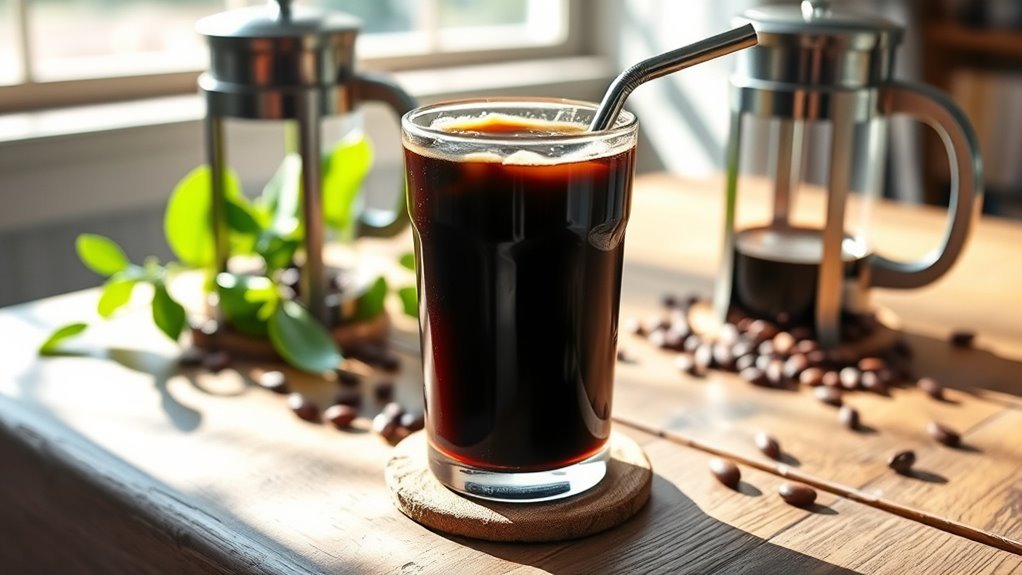
When you choose cold brew, you reduce energy consumption since it requires no heating during extraction. This method also generates less waste because it yields a concentrated brew, minimizing the volume of coffee grounds discarded. Understanding these factors highlights cold brew’s potential to lessen environmental impact compared to traditional brewing.
Reduced Energy Consumption
Because cold brew coffee relies on steeping grounds in cold water over an extended period rather than heating water to boiling temperatures, it greatly reduces energy consumption during preparation. You benefit from improved energy efficiency by eliminating the need for electric kettles or gas burners, which consume significant power during rapid heating. This method aligns with resource sustainability principles by lowering your carbon footprint and minimizing dependence on electricity or fossil fuels. Additionally, cold brew’s slower extraction process uses ambient temperature, so you’re not expending energy on temperature regulation. By choosing cold brew, you actively reduce unnecessary energy demand in your daily routine, supporting a freer lifestyle that values autonomy and environmental responsibility. This approach promotes smarter resource use without compromising on coffee quality or flavor intensity.
Less Waste Produced
Waste reduction stands as a key environmental advantage of cold brew coffee preparation. When you choose cold brew, you’re engaging with a process that typically uses coarser grounds, which can be more efficiently extracted, reducing coffee waste. Sustainable sourcing guarantees that the coffee beans come from farms practicing responsible land management, minimizing environmental degradation. Additionally, many cold brew brands prioritize eco friendly packaging, employing recyclable materials that lower landfill contributions. By selecting cold brew options with these attributes, you actively support reduced resource consumption and waste generation in the coffee supply chain. This approach aligns with your desire for freedom—freedom from excessive environmental impact and dependence on single-use plastics—empowering you to make a tangible difference with every cup you enjoy.
Frequently Asked Questions
Can Cold Brew Coffee Be Made With Decaffeinated Beans?
Yes, you can make cold brew coffee with decaffeinated beans. Using decaf offers benefits like reduced caffeine intake while maintaining flavor complexity. The brewing technique remains similar: steep coarse-ground decaf beans in cold water for 12-24 hours, allowing full extraction without bitterness. This method preserves delicate notes and guarantees a smooth, rich profile. By choosing decaf cold brew, you enjoy freedom from caffeine jitters without sacrificing taste or craftsmanship.
What Is the Best Type of Water to Use for Cold Brew?
Imagine brewing your cold brew with water from a Renaissance fountain—sounds charming, right? In reality, you want filtered water with balanced mineral content for the best extraction. Too many minerals can overpower flavors; too few can leave your brew flat. Using filtered water guarantees impurities are removed, giving your coffee clarity and letting the beans’ true character shine. This precision lets you craft a beverage that’s as liberating as a fresh morning breeze.
How Should Cold Brew Coffee Be Stored After Brewing?
After brewing, you should immediately transfer your cold brew coffee into airtight storage containers to preserve freshness. Glass jars or BPA-free plastic containers work best. For peak quality, refrigeration is essential; keep the cold brew at a consistent temperature between 35-40°F. Follow refrigeration tips like avoiding frequent temperature changes and storing away from strong odors. Properly stored, your cold brew can last up to two weeks without losing flavor or aroma.
Is Cold Brew Coffee Safe for Pregnant Women?
Imagine Jane, who’s carefully tracking her caffeine intake during pregnancy. According to pregnancy guidelines, you should limit caffeine consumption to about 200 mg daily. Cold brew coffee often contains higher caffeine levels than regular coffee, so you’ll need to measure your intake precisely. While cold brew isn’t inherently unsafe, exceeding recommended caffeine amounts can pose risks. Always consult your healthcare provider to balance your freedom to enjoy coffee with pregnancy safety.
Can Cold Brew Coffee Be Used in Cocktails?
Absolutely, you can use cold brew coffee in cold brew cocktails to elevate your coffee mixology game. Its smooth, low-acid profile blends seamlessly with spirits like bourbon or rum, creating balanced, complex flavors without bitterness. When crafting cocktails, precise ratios matter—typically 1:1 cold brew to spirit works well. You’ll enjoy the freedom to experiment with syrups, bitters, or citrus, customizing each cold brew cocktail to suit your taste preferences perfectly.
